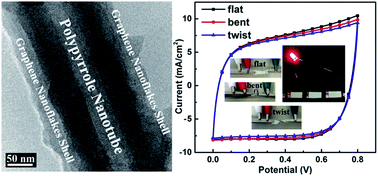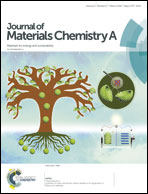A core/shell structured tubular graphene nanoflake-coated polypyrrole hybrid for all-solid-state flexible supercapacitors†
Abstract
A core/shell tubular structured graphene nanoflake-coated polypyrrole nanotube (GNF/PNT) hybrid is fabricated for all-solid-state flexible supercapacitors. Functionalization of a controlled coating amount of GNFs onto PNTs is achieved via chemical covalent bonds generated by acylation of the N–H positions of the PNT surface with the carboxyl groups of GNFs. The GNF coating not only acts as an efficient surface protector, but also serves as the electron transfer pathway; meanwhile, a controlled coating amount of GNFs optimizes the capacitance of the whole composite. A stable cycling performance and large capacitance as well as high capacitance retention of the GNF/PNT hybrid are therefore achieved. A flexible all-solid-state symmetric supercapacitor device is also assembled, which demonstrates (at 1.8 mA cm−2) an areal capacitance of 128 mF cm−2, an energy density of 11.4 μW h cm−2 at a power density of 720 μW cm−2, and a cycling stability of over 80% capacitance retention after 5000 cycles. This study demonstrates a facile strategy for designing novel conductive polymers/graphene composites with enhanced cycling stability in all-solid-state flexible supercapacitors and beyond.



 Please wait while we load your content...
Please wait while we load your content...